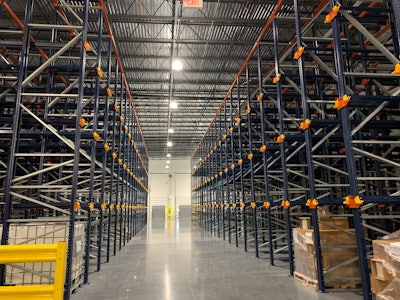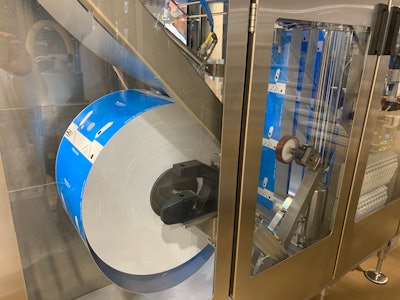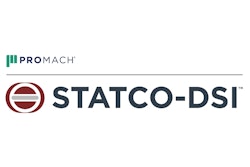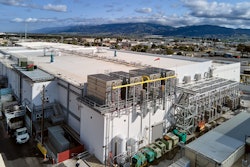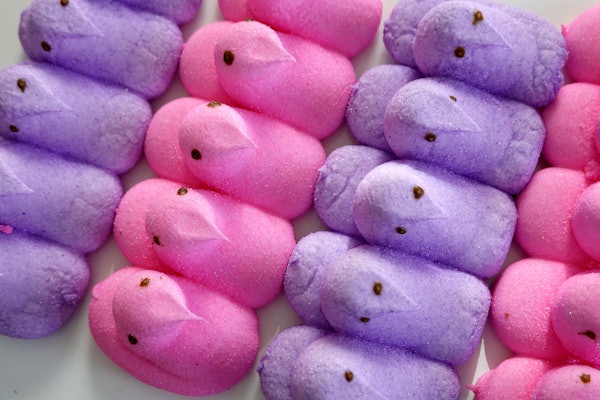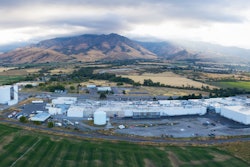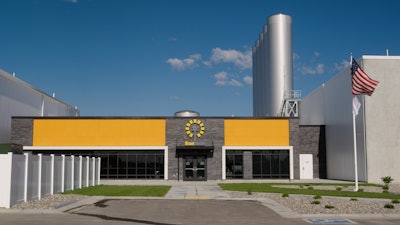
What You Will Learn in This Story:
- Why aseptic milk production creates the potential for international sales.
- How aseptic processing can cut the cost of cold storage and refrigeration.
- Why contract manufacturers need to be fully certified before producing any food or beverage items.
Traditional high-temperature, short time (HTST) milk production has often been limited by its relatively short expiration date—just a few weeks—and the need to be refrigerated throughout the entirety of the cold foods supply chain. That short shelf life keeps HTST milk produced in the U.S. from making its way to regional areas like Mexico and South America, and far-off markets like China and Taiwan, for example.
Aseptic dairy processing and packaging changed that scenario, with milk produced through ultra-high temperatures (UHT) and filled into sterile, oxygen-free aseptic packaging. That milk has a shelf-life of up to 12 months, which means those far-away markets are now accessible for U.S. dairy manufacturers, since refrigeration is not required once the milk is sealed in aseptic containers. This opens the door to distribution in emerging economies as well, where refrigeration may be inconsistent or scarce.
Another variation with a shorter shelf life—about 80 to 100 days—is extended shelf life (ESL) processing and packaging. ESL milk lasts much longer than HTST milk but requires end-to-end refrigeration throughout its lifespan.
 | See how Taylor Farms rebuilt its flagship foodservice facility after disaster. |
Both aseptic and ESL milk are produced at the new Suntado plant in Burley, Idaho, located in the dairy-rich Magic Valley region of the state. Suntado is a new, vertically integrated processor specializing in contract manufacturing of aseptic and ESL organic and conventional milk products, along with plant-based beverages, with options for value-added blending of flavors, and lactose-free and vitamin dosing for functional drinks.
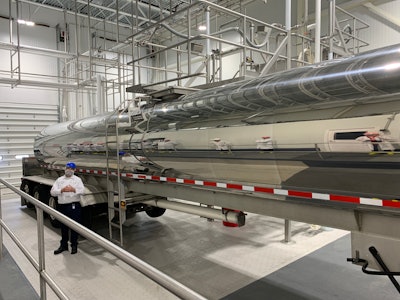 Suntado Plant Manager Russ Lucas stands next to a milk tanker truck that only needed to travel 20 miles from farm to factory for processing. This vertically integrated business model ensures fresher product and a lower carbon footprint for transportation.Michael Costa
Suntado Plant Manager Russ Lucas stands next to a milk tanker truck that only needed to travel 20 miles from farm to factory for processing. This vertically integrated business model ensures fresher product and a lower carbon footprint for transportation.Michael Costa
The name Suntado comes from its two founders, Dirk Reitsma, owner and manager of Sunrise Organic Dairy, and Jesus Hurtado, owner of Hurtado Dairy. Sunrise + Hurtado = Suntado. Both farms are approximately 20 miles from the Suntado facility. Reitsma’s farm has 5,500 cows and can produce 400,000 lbs of organic milk daily. Hurtado oversees 28,000 cows, and can produce 2 million lbs of conventional milk daily.
Combined, this vertically integrated business model not only supplies Suntado with a steady stream of fresh milk—which can be processed and packaged the same day—but the short distance to travel from farm to factory helps keep Suntado’s carbon footprint low.
“Before Suntado, Dirk and Jesus would ship their milk to customers in other states, and in some instances, as far away as the East Coast,” says Tory Nichols, office of the CEO, business development at Suntado. “Now they’re just driving it 20 miles to their own facility, so there’s a strong sustainability point just around the transportation of milk from the dairies to the plant.”
Eco-friendly initiatives and efficiencies throughout Suntado’s plant help position it as a potential leader in the marketplace as the company ramps up its first year of business. Here, we’ll take a detailed look inside the greenfield facility, which was designed and built by Big-D Construction and E.A. Bonelli + Associates.
Aseptic advantages
Suntado currently has two processing lines and six fillers: four aseptic and one ESL from Tetra Pak, and one ESL from Pactiv Evergreen. The 190,000-sq-ft plant was built with extra space to house up to six processors and 18 filling lines operating in the facility—three times what is currently in place now. At full capacity currently, Suntado can produce more than 33 million gallons a year, and after expansion, about 100 million gallons annually.
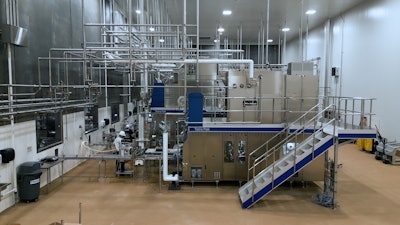 Suntado currently has six fillers—four aseptic and two ESL—and finished cartons are conveyed to the left into the end-of-line space on the other side of the wall.Tetra Pak
Suntado currently has six fillers—four aseptic and two ESL—and finished cartons are conveyed to the left into the end-of-line space on the other side of the wall.Tetra Pak
The process starts when milk is trucked in by tanker to a receiving area. Milk is stored in stainless-steel silos until it’s ready for separation, standardization, or processing. Once milk is processed through UHT it’s stored in aseptic surge tanks and can be routed to the aseptic filling lines where cartons are filled and sealed, then conveyed to Robopac case packers and TopTier palletizers for eventual distribution.
“There’s a substantial amount of effort that goes into making a sterile product,” says Russ Lucas, Suntado’s plant manager. “You need the boilers going, and then the chillers need to be operating as well. You turn the temperature up to the 285-degree range [for UHT processing] then you need to cool it back down to 80 degrees. Or, if the milk is going out to ESL, then down to 36 degrees. So, there’s a lot of change in temperature and a lot of movement of product around.”
As noted earlier, aseptic containers give Suntado a chance to manufacture milk and other beverages for customers around the world because it doesn’t need to be refrigerated until the container is opened. This means Suntado can schedule longer continuous production runs with less waste in the end. Milk is stored in stainless-steel silos until it’s ready for separation, standardization, or processing. Once milk is processed through UHT it’s stored in aseptic surge tanks and can be routed to aseptic filling lines.Michael Costa
Milk is stored in stainless-steel silos until it’s ready for separation, standardization, or processing. Once milk is processed through UHT it’s stored in aseptic surge tanks and can be routed to aseptic filling lines.Michael Costa
“I’m not going to be squeezed into a 25- or 30-day window to get product out the door before it goes past its best-by date,” says Lucas. “[Aseptic] gives us a certain amount of flexibility, and our plan is to get as close as we can to 24-hour [production] runs. Our strategy is to plan ahead to manage our product mix so that we don’t have multiple changeovers and force extra CIPs (clean-in-place) and the associated downtime.”
Mat Rutz, VP of contract manufacturing for Tetra Pak in the U.S. and Canada, adds, “Aseptic lines run faster than the alternative packaging technologies, and you can schedule your production around to get the maximum benefit out of the technology,” he says. “In principle, because the [aseptic] product will last longer as opposed to a traditional dairy environment—where the milk is going to spoil in a few weeks so you have to build that into your scheduling on a weekly basis—you can lengthen your runs and reduce your CIPs, which means you eventually reduce the amount of product down the drain.”
